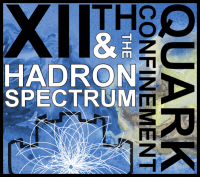Speaker
Description
In this work, we pint out that there exists an approximate degeneracy among heavy-light systems with the same $L$.
This is supported by an experimental fact which can be seen from the observed data. This approximate symmetry explains why the GI model obtains results similar to those of the heavy-light systems which are fitted well with experimental data. This is because the GI model has this symmetry from the beginning which is broken by the spin-orbit interactions. Numerical results of the GI model together with those of other models respecting heavy quark symmetry are compared with the experimental data of the $D$ mesons and they well give similar results to each other.
We analytically show that expectation values of $[H_0,\vec L^{~2}]$ give us at most of the order of $1/m_Q$ for $0^-$ and $1^-$ states and the similar arguments will give us the same conclustion for other higher states in our model which respects heavy quark symmetry. Note that this order of magnitude, $1/m_Q$, is the same as those which break degeneracy of a spin doublet of heavy-light systems. It is shown that there is a rotational symmetry in the limit of $m_Q\to \infty$ and nonrelativistic limit of heavy-quark symmetry.
Simple application of our idea to other states can be given by baryons $QQq$ like $\Xi_{cc}^+$, multiquark states in which one light quark is included like $QQ\bar Qq$, and probably other states in which a couple of light quarks can be regarded as a brown mock. A good expample is given by a spectrum of $\Lambda_c$ which gives us $\Lambda_c(2286)$ with $L=0$, $\Lambda_c^+(2595)$ and $\Lambda_c^+(2625)$ with $L=1$, and $\Lambda_c^+(2880)$ and $\Lambda_c^+(2940)$ with $L=2$, where a spin multiplet is given by member/members with the same $L$. $L$ is defined by an angular momentum between a heavy quark $c$ and two light quarks $(ud)$. One can easily see that gaps between different spin multiplets are nearly equal to $\Lambda_{QCD}\sim 300$ MeV, which coincides with the observation of heavy-light mesons.
This property may be explainged by adopting a string picture of a heavy-light system, i.e., having a fixed end and a free end and connecting both ends with a string.
Summary
Careful observation of the experimental spectra of heavy-light mesons tells us that heavy-light mesons with the same angular momentum $L$ are almost degenerate. The estimate is given how much this degeneracy is broken in our relativistic potential model, and it is analytically shown that expectation values of a commutator between the lowest order Hamiltonian and ${\vec L}^{~2}$ are of the order of $1/m_Q$ with a heavy quark mass $m_Q$. It turns out that nonrelativistic approximation of heavy quark system has a rotational symmetry and hence degeneracy among states with the same $L$. This property may be explainged by adopting a string picture of a heavy-light system, i.e., having a fixed end and a free end and connecting both ends with a string. This feature can be tested by measuring higher orbitally and radially excited heavy-light meson spectra for $D/D_s/B/B_s$ in LHCb and forthcoming BelleII.




